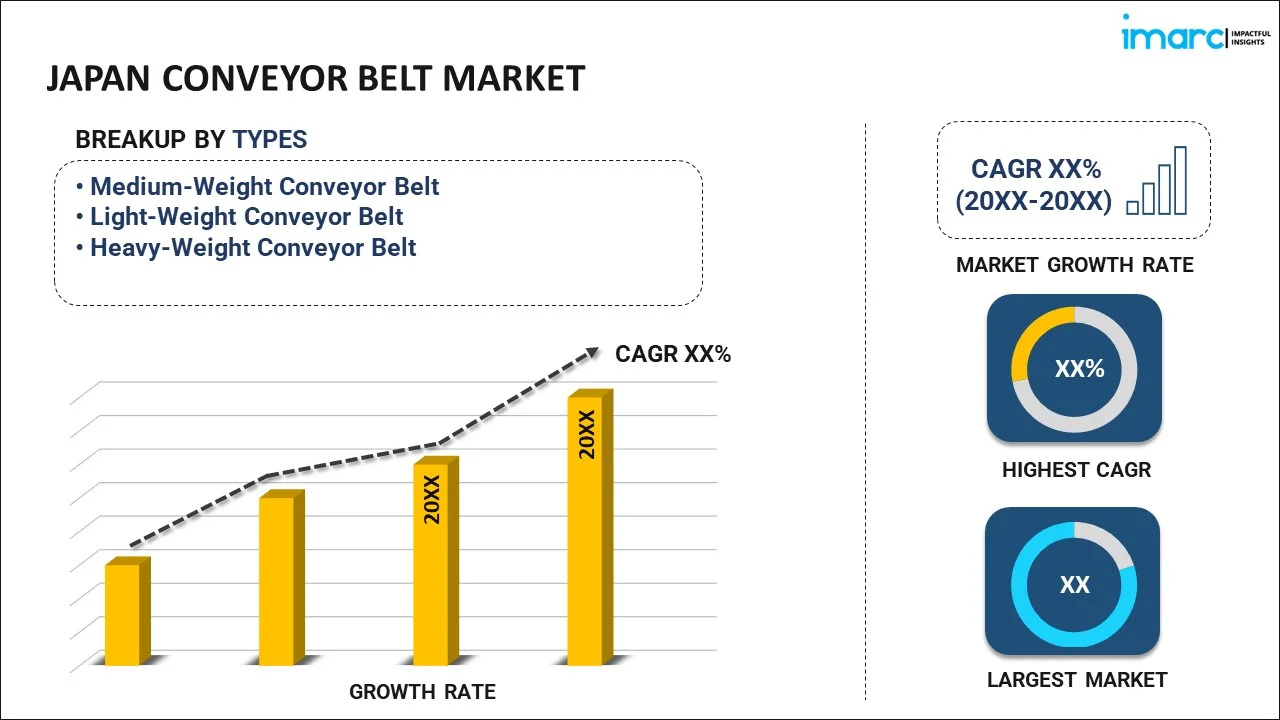
Japan Conveyor Belt Market Report by Type (Medium-Weight Conveyor Belt, Light-Weight Conveyor Belt, Heavy-Weight Conveyor Belt), End Use (Mining and Metallurgy, Manufacturing, Chemicals, Oils and Gases, Aviation, and Others), and Region 2025-2033
Market Overview:
The Japan conveyor belt market size reached USD 641 Million in 2024. Looking forward, IMARC Group expects the market to reach USD 1,019 Million by 2033, exhibiting a growth rate (CAGR) of 5.3% during 2025-2033.
|
Report Attribute
|
Key Statistics
|
|---|---|
|
Base Year
|
2024
|
|
Forecast Years
|
2025-2033
|
|
Historical Years
|
2019-2024
|
|
Market Size in 2024
|
USD 641 Million |
|
Market Forecast in 2033
|
USD 1,019 Million |
| Market Growth Rate (2025-2033) | 5.3% |
A conveyor belt is a continuous carrying medium used in a belt- and pulley-based conveyor system. It is commonly available in heavy-weight, medium-weight and lightweight variants. These belts are used to move products and materials from one point to another in a straight line or through changes in elevation or direction. They are connected to a central operating system and can be operated at varying speeds. They are manufactured using rubber, polyvinyl chloride (PVC) or plastic compounds and consist of multiple layers of fabrics that increase the load-bearing capacity of the belt. They find extensive applications across various industries, such as construction, mining and food packaging.
The Japan conveyor belt market is primarily being driven by the widespread product utilization in the food and beverage industry for baking, dough processing and meat and poultry processing. Conveyor belts are also used in sushi restaurants for rotating food on tables and providing high-speed foodservice and improved customer service. Moreover, the increasing demand for conveyor belts to handle baggage at airports and shipping docks is favoring the market growth. Additionally, various product innovations, such as the development of heat-resistant conveyor belts that are used for material handling in high-temperature environments, are positively impacting the market growth. Other factors, including increasing automation in the manufacturing industry and widespread product utilization to transport ores and concentrates in various mining operations, are anticipated to drive the market growth across the country.
Key Market Segmentation:
IMARC Group provides an analysis of the key trends in each sub-segment of the Japan conveyor belt market report, along with forecasts at the country and regional levels from 2025-2033. Our report has categorized the market based on type and end use.
Breakup by Type:

- Medium-Weight Conveyor Belt
- Light-Weight Conveyor Belt
- Heavy-Weight Conveyor Belt
Breakup by End Use:
- Mining and Metallurgy
- Manufacturing
- Chemicals, Oils and Gases
- Aviation
- Others
Breakup by Region:
.webp)
- Kanto Region
- Kinki Region
- Central/ Chubu Region
- Kyushu-Okinawa Region
- Tohoku Region
- Chugoku Region
- Hokkaido Region
- Shikoku Region
Competitive Landscape:
The competitive landscape of the industry has also been examined along with the profiles of the key players.
Report Coverage:
| Report Features | Details |
|---|---|
| Base Year of the Analysis | 2024 |
| Historical Period | 2019-2024 |
| Forecast Period | 2025-2033 |
| Units | Million USD |
| Segment Coverage | Type, End Use, Region |
| Region Covered | Kanto Region, Kinki Region, Central/ Chubu Region, Kyushu-Okinawa Region, Tohoku Region, Chugoku Region, Hokkaido Region, Shikoku Region |
| Customization Scope | 10% Free Customization |
| Post-Sale Analyst Support | 10-12 Weeks |
| Delivery Format | PDF and Excel through Email (We can also provide the editable version of the report in PPT/Word format on special request) |
Key Questions Answered in This Report
The Japan conveyor belt market was valued at USD 641 Million in 2024.
We expect the Japan conveyor belt market to exhibit a CAGR of 5.3% during 2025-2033.
The sudden outbreak of the COVID-19 pandemic has led to the increasing adoption of conveyor belts across various industry verticals, such as food and beverages, packaging, logistics, etc., to automate numerous operations and limit human interaction for reducing the risk of coronavirus infection across the nation.
The emerging trend of industrial automation, along with the growing demand for advanced conveyor belts with self-cleaning properties, improved operational costs, high energy-efficiency, etc., is primarily driving the Japan conveyor belt market.
Based on the type, the Japan conveyor belt market has been divided into medium-weight conveyor belt and light-weight conveyor belt, and heavy-weight conveyor belt. Among these, medium-weight conveyor belt currently holds the majority of the total market share.
Based on the end use, the Japan conveyor belt market can be bifurcated into mining and metallurgy, manufacturing, chemicals, oils and gases, aviation, and others. Currently, mining and metallurgy exhibits a clear dominance in the market.
On a regional level, the market has been classified into Kanto Region, Kinki Region, Central/ Chubu Region, Kyushu-Okinawa Region, Tohoku Region, Chugoku Region, Hokkaido Region, and Shikoku Region, where Kanto Region currently dominates the Japan conveyor belt market.
Need more help?
- Speak to our experienced analysts for insights on the current market scenarios.
- Include additional segments and countries to customize the report as per your requirement.
- Gain an unparalleled competitive advantage in your domain by understanding how to utilize the report and positively impacting your operations and revenue.
- For further assistance, please connect with our analysts.
 Inquire Before Buying
Inquire Before Buying
 Speak to an Analyst
Speak to an Analyst
 Request Brochure
Request Brochure
 Request Customization
Request Customization




.webp)




.webp)












